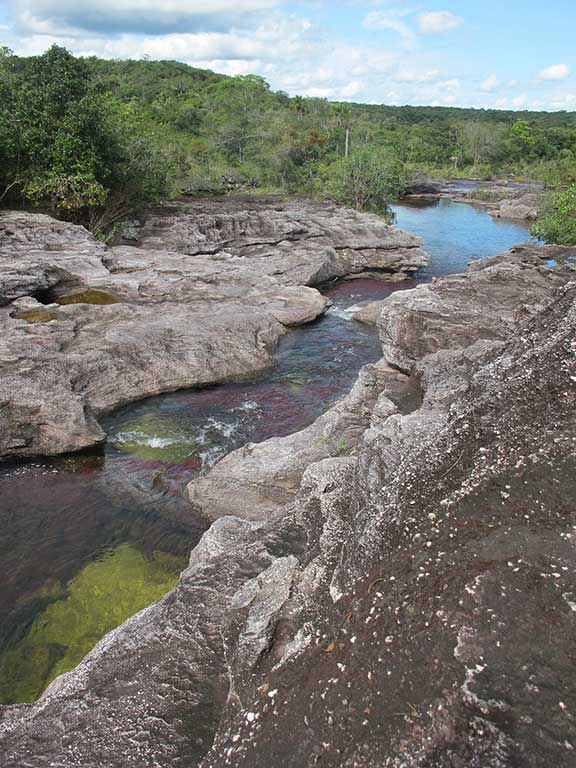Taking a flight (or two) to a remote corner of Colombia with a troubled past just to see some river algae may not, on the surface, sound like a wise investment of precious vacation time. But, here in the remote Llanos, you’ll be rewarded as you trek through the stark lowland hills of the Serranía de la Macarena, with its unusual dry tropical vegetation, and behold the vibrant purple, fuchsia, goldenrod, and green Macarenia clavigera plants swaying in the gushing streams of Caño Cristales.

The colorful pools of Caño Cristales. Photo © Andrew Dier.
A highly successful nature guide training program for high school students has given youths in the town the opportunity to gain a living through ecotourism.The Serranía de la Macarena (Macarena Range) is a 120-kilometer-long, 30-kilometer-wide (75-mile-long, 19-mile wide) mountain range 70 kilometers (43 miles) south of Villavicencio and 45 kilometers (28 miles) east of the Andes. The range, which is entirely contained within the 629,280-hectare (1.6 million-acre) Parque Nacional Natural Sierra de la Macarena, is the highly eroded remnant of mountains that once towered on the supercontinent of Panagea, before the South American plate separated from the African plate and drifted westward to its present location, crashing into the Nazca plate and creating the Andes. These ancient outcrops, which form the Guyana Shield, dot the northwest Amazon basin in Colombia, Venezuela, and Guyana.The Macarena is also unique in that it is at the confluence of three highly distinct ecosystems: the Amazon to the south, the Llanos to the north, and the Andes mountain rainforests to the west. A large number of endemic plants evolved in this isolated mountain range, including the striking Macarenia clavigera, which draws tourists from all over Colombia and from abroad.
Caño Cristales is a stream that flows from west to east in the very southern part of the sierra and flows into the Río Guayabero, a tributary of the Río Guaviare. In its upper reaches, it has three branches that join to form the Caño Cristales stream proper. The surrounding landscape is quite dry and rocky, covered with unusual Vellozia macarenensis plants, which have evolved to survive the dry climate and bush fires. These plants produce beautiful white flowers that add to the beauty of the stark environs.
The small town of La Macarena on the Río Guayabero is the gateway to Caño Cristales. It was part of the demilitarized zone granted to the FARC as part of the 1998-2002 peace process. Evincing little respect for nature, the FARC destroyed the park facilities, chased away the staff, and built a road right through the park, sparking squatters to take illegal possession of lands within the park. The town of La Macarena is now home to a 4,000-strong army base, one of the largest in Colombia. The areas in the vicinity of the town are safe to visit. Tourism has given this isolated community new life. A highly successful nature guide training program for high school students has given youths in the town the opportunity to gain a living through ecotourism. Six thousand visitors came to Caño Cristales in 2012, and each year more and more are coming.
To visit Caño Cristales, you need a minimum of one full day and two nights, but staying a day or two longer is definitely worthwhile. The best time of the year to visit is during the rainy season, from May until November, when you can marvel at the Macarenia clavigera in bloom.
All excursions require a guide. Visitors are asked to avoid using sunscreen or mosquito repellent, as it can damage the Macarenia clavigera. Therefore, make sure to bring a wide-brimmed sun hat and wear lightweight, long-sleeve shirts and pants to protect your skin. Wear shoes that have good traction on slippery rocks and that you don’t mind getting wet.
![Caño Cristales. Phto © Mario Carvajal (Own work) [<a href="http://creativecommons.org/licenses/by/3.0">CC BY 3.0</a>], <a href="https://commons.wikimedia.org/wiki/File%3ACA%C3%91O_CRISTALES%2C_SECTOR_LOS_OCHOS_(COLOMBIA).jpg">via Wikimedia Commons</a>.](https://www.holidaytravel.cc/Article/UploadFiles/201602/2016021615071268.jpg)
Caño Cristales. Phto © Mario Carvajal (Own work) [CC BY 3.0], via Wikimedia Commons.
The most popular trek is a half-day excursion that involves a pleasant 20-minute boat ride up the Río Guayabero from the town of La Macarena, a six-kilometer (3.7-mile) truck ride, and a two-kilometer (1.2 mile) hike to Caño Cristales. There, you’ll admire the multicolored stream as it gushes through pools and waterfalls. At the end you get to cool off in the Piscina del Turista, a natural pool, and have a waterside lunch.Another longer, all-day excursion takes you to the upper part of Caño Cristales, where you’ll visit the three different branches of the river. The vegetation here is much denser, and the Macarenia clavigera also take on yellow and green hues. This excursion involves wading across the stream numerous times. If it has been raining, the level and force of the water increases considerably, making for an exhilarating experience. Depending on the level of the water and physical conditions of the trip, you may visit one, two, or all three of the branches.
Two other half-day excursions also involve a ride up the Río Guayabero to visit Cristalitos, a smaller stream that is Caño Cristales in miniature, or to El Mirador, a hike to the top of a hill that offers sweeping views of the Río Guayabero and surrounding countryside.
Another excursion, which can only be done in the dry months of December through April, is 20 kilometers (12 miles) up to the Raudal del Guayabero to admire the white-water rapids, ancient indigenous petroglyphs, and interesting rock formations known as Ciudad de Piedra.
Excerpted from the First Edition of Moon Colombia.